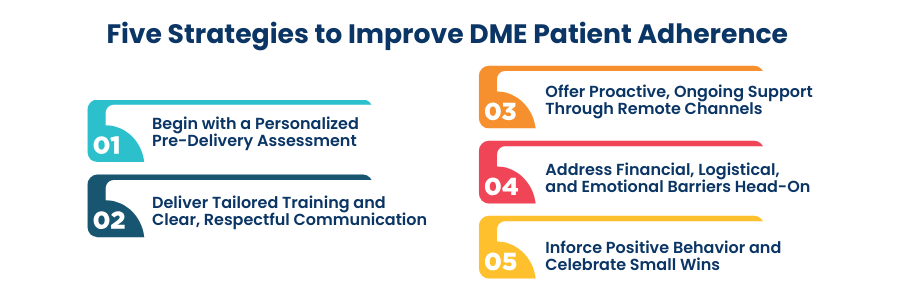The delivery of Durable Medical Equipment (DME) is no longer a one-time event—it marks the beginning of an essential, ongoing relationship between the provider and the patient. For individuals managing chronic conditions, post-operative recovery, or mobility limitations, receiving DME signals a major lifestyle shift. The success of these devices lies not only in their quality or function, but in how effectively patients are supported in using them consistently and correctly.
Today, DME patient adherence has emerged as a critical performance indicator—not just for DME suppliers, but for health plans, care managers, and integrated delivery systems. As the healthcare landscape continues to evolve, technology, personalization, and empathy must converge to meet rising expectations for outcomes, efficiency, and patient experience.
Understanding the Challenges Behind DME Patient Adherence
Historically, the DME experience has been transactional. Equipment is delivered, basic instructions are provided, and the expectation is that the patient will figure it out from there. However, this approach often ignores the real-world barriers patients face: anxiety, frustration, confusion, and, in many cases, isolation.
A recent global survey published by The Ophthalmologist underscores this disconnect—patients overwhelmingly reported a desire for more detailed and empathetic discussions with care providers. They want to understand how therapy will affect their daily lives, what outcomes they can realistically expect, and how to manage the financial and logistical challenges that often accompany long-term equipment use.
When this support is lacking, DME patient adherence suffers. Devices go unused or are abandoned altogether, resulting in poorer health outcomes, higher readmission rates, and increased healthcare costs.
The Role of Empathy and Technology in DME Engagement
To improve adherence, DME providers and healthcare organizations must embrace a member-centric model built on empathy and enablement. Fortunately, advances in the Internet of Medical Things (IoMT) have opened new pathways for delivering just that.
IoMT-enabled DME devices—such as connected CPAP machines, glucose monitors, or infusion pumps—can transmit real-time data to care teams, enabling timely interventions when non-adherence patterns are detected. According to insights from SuperStaff.com, these smart technologies are enhancing the healthcare delivery model by creating a feedback loop between patients, devices, and care coordinators.
However, while technology plays a pivotal role, it cannot replace the human connection. The most effective approach to improving DME patient adherence blends advanced tech with personalized, compassionate support.
Five Strategies to Improve DME Patient Adherence

1. Begin with a Personalized Pre-Delivery Assessment
Improving adherence starts long before the device arrives. A thoughtful intake process helps providers assess more than just the clinical need—it uncovers lifestyle factors, emotional concerns, and physical limitations that may impact usage. Providers should ask open-ended questions to gain insight into the patient’s daily routines, home environment, and prior experience with medical devices.
When applicable, this is also the ideal time to introduce IoMT-enabled devices and explain how remote monitoring can simplify their experience. Setting the tone early with a personalized, patient-first approach increases engagement and lays the foundation for adherence.
2. Deliver Tailored Training and Clear, Respectful Communication
Every patient learns differently. Whether in-person or via digital platforms, providers must adapt the training to suit individual learning styles—visual aids, simple printed guides, and even short video demonstrations can all be helpful.
Avoid clinical jargon. Replace terms like “calibration” or “interface seal” with plain, empowering language. For example, instead of saying “adjust the pressure settings,” say “turn the dial slowly until you feel comfortable breathing.”
This approach demystifies the device, reduces anxiety, and increases the likelihood of daily use—all key factors in improving DME patient adherence.
3. Offer Proactive, Ongoing Support Through Remote Channels
Support shouldn’t stop after setup. Regular follow-ups via phone, SMS, email, or video calls ensure that patients feel continuously cared for. IoMT data can trigger automated alerts to providers when usage drops, prompting outreach that’s timely and targeted.
Moreover, consistent communication builds trust. Asking questions like, “How is the equipment fitting into your day?” or “Have you noticed any discomfort?” shows that the provider cares beyond the prescription. Even small gestures—like a monthly check-in—can prevent abandonment and reinforce adherence.
4. Address Financial, Logistical, and Emotional Barriers Head-On
Even the most willing patients may face hurdles. Frequent appointments, transportation needs, or high out-of-pocket costs can all derail adherence. Providers must advocate for patients by coordinating with insurers, offering flexible payment plans, and minimizing the need for unnecessary in-person visits through remote monitoring tools.
Importantly, the emotional aspect must not be overlooked. Chronic illness and long-term device usage often lead to mental health challenges. Depression, frustration, and social isolation are common. Providers should screen for these factors and offer referrals to behavioral health resources or support groups when needed. By normalizing these conversations, they contribute to holistic patient care.
5. Reinforce Positive Behavior and Celebrate Small Wins
Adherence improves when patients feel empowered, not obligated. Acknowledge milestones—such as consistent usage over a week or visible improvements in symptoms. Statements like, “You’ve done a great job using your CPAP every night this week—how are you feeling?” help patients internalize success and build confidence.
Positive reinforcement turns daily usage into a self-motivated habit, strengthening long-term DME patient adherence.
The Home Healthcare Shift and the Rise of Portable DME
Healthcare is increasingly moving into the home, accelerated by patient preference, technological innovation, and cost containment pressures. The growth of the portable DME market—such as mobile oxygen concentrators—reflects this shift, allowing patients to maintain mobility and independence while managing their conditions effectively.
To support this evolution, providers must adopt engagement models that are equally mobile and adaptive. IoMT-enabled devices, virtual coaching, and multilingual support services are essential components of a modern DME strategy.
Building Trust for Lasting Patient Engagement
Ultimately, improving DME patient adherence comes down to trust. When patients believe that their provider understands their journey, respects their concerns, and is invested in their well-being, they are more likely to stay engaged and compliant.
This trust cannot be built overnight. It requires consistent communication, thoughtful education, technology-enabled responsiveness, and most importantly, a sincere demonstration of empathy at every touchpoint.
How Fusion CX Empowers DME Providers with Empathy-Led Engagement
At Fusion CX, we help healthcare organizations go beyond equipment delivery. We provide human-centered support for long-term success.
Our approach blends empathetic, multilingual engagement with AI-driven tools. These include remote monitoring, automated follow-ups, and digital education. With 20+ years of global experience in 15+ countries, we partner with top healthcare providers and payers. Our goal: improve DME adherence, reduce abandonment, and boost satisfaction.
We train agents in both process and emotional intelligence. Through voice, chat, email, or video, they offer personalized support. This makes the DME experience easier, more approachable, and more sustainable.
As DME becomes key to home-based care, Fusion CX stays committed. We help healthcare organizations deliver support with compassion, clarity, and results.

